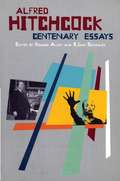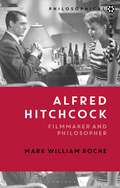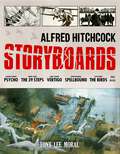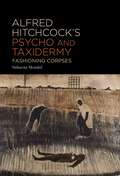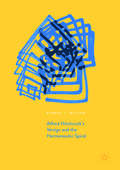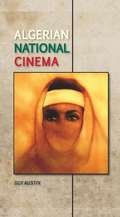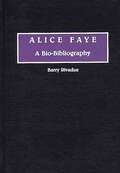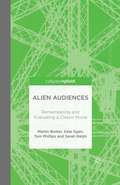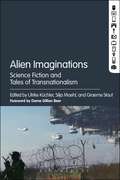- Table View
- List View
Alfred Hitchcock: Centenary Essays
by Richard Allen S. Ishii-GonzalèsThis collection of essays displays the range and breadth of Hitchcock scholarship and assesses the significance of his body of work as a bridge between the fin de siecle culture of the 19th century and the 20th century. It engages with Hitchcock's characteristic formal and aesthetic preoccupations.
Alfred Hitchcock
by Nicholas HaeffnerNicholas Haeffner provides a comprehensive introduction to Alfred Hitchcock's major British and Hollywood films and usefully navigates the reader through a wealth of critical commentaries. One of the acknowledged giants of film, Hitchcock's prolific half-century career spanned the silent and sound eras and resulted in 53 films of which Rear Window (1954), Vertigo (1958) and Psycho (1960) are now seen as classics within the suspense, melodrama and horror genres. In contrast to previous works, which have attempted to get inside Hitchcock's mind and psychoanalyse his films, this book takes a more materialist stance. As Haeffner makes clear, Hitchcock was simultaneously a professional film maker working as part of a team in the film factories of Hollywood, a media celebrity, and an aspiring artist gifted with considerable entrepreneurial flair for marketing himself and his films. The book makes a case for locating the director's remarkable body of work within traditions of highbrow, middlebrow and lowbrow culture, appealing to different audience constituencies in a calculated strategy. The book upholds the case for taking Hitchcock's work seriously and challenges his popular reputation as a misogynist through detailed analyses of his most controversial films.
Alfred Hitchcock
by Nicholas HaeffnerNicholas Haeffner provides a comprehensive introduction to Alfred Hitchcock's major British and Hollywood films and usefully navigates the reader through a wealth of critical commentaries. One of the acknowledged giants of film, Hitchcock's prolific half-century career spanned the silent and sound eras and resulted in 53 films of which Rear Window (1954), Vertigo (1958) and Psycho (1960) are now seen as classics within the suspense, melodrama and horror genres. In contrast to previous works, which have attempted to get inside Hitchcock's mind and psychoanalyse his films, this book takes a more materialist stance. As Haeffner makes clear, Hitchcock was simultaneously a professional film maker working as part of a team in the film factories of Hollywood, a media celebrity, and an aspiring artist gifted with considerable entrepreneurial flair for marketing himself and his films. The book makes a case for locating the director's remarkable body of work within traditions of highbrow, middlebrow and lowbrow culture, appealing to different audience constituencies in a calculated strategy. The book upholds the case for taking Hitchcock's work seriously and challenges his popular reputation as a misogynist through detailed analyses of his most controversial films.
Alfred Hitchcock: Filmmaker and Philosopher (Philosophical Filmmakers)
by Mark William RocheHitchcock was a masterful director, popular with audiences of all ages and critically acclaimed both during and after his unusually long career. What may have been sensed by many viewers but not fully articulated until now is the extent to which his works subtly engage philosophical themes: What is evil, and how does it shield and reveal itself? Can we know what is inside the mind of another person? What is at stake when one knows the truth but cannot speak of it or cannot persuade others? How is Hitchcock's loving critique of humanity manifested in his films? Why are Hitchcock's works so often ambiguous? What is the hidden purpose and theory behind his use of humor?Hitchcock employs cinematic techniques–from camera angles and use of light to editing and sound–partly to convey suspense and drama but also to engage and advance philosophical issues, ranging from identity crises to moral ugliness. Roche unlocks Hitchcock's engagement with philosophical themes, and he does so in a way that appeals to both the novice and the seasoned philosopher, as well as enthusiastic admirers of Hitchcock's films.
Alfred Hitchcock: Filmmaker and Philosopher (Philosophical Filmmakers)
by Mark William RocheHitchcock was a masterful director, popular with audiences of all ages and critically acclaimed both during and after his unusually long career. What may have been sensed by many viewers but not fully articulated until now is the extent to which his works subtly engage philosophical themes: What is evil, and how does it shield and reveal itself? Can we know what is inside the mind of another person? What is at stake when one knows the truth but cannot speak of it or cannot persuade others? How is Hitchcock's loving critique of humanity manifested in his films? Why are Hitchcock's works so often ambiguous? What is the hidden purpose and theory behind his use of humor?Hitchcock employs cinematic techniques–from camera angles and use of light to editing and sound–partly to convey suspense and drama but also to engage and advance philosophical issues, ranging from identity crises to moral ugliness. Roche unlocks Hitchcock's engagement with philosophical themes, and he does so in a way that appeals to both the novice and the seasoned philosopher, as well as enthusiastic admirers of Hitchcock's films.
Alfred Hitchcock: Centenary Essays
This collection of essays displays the range and breadth of Hitchcock scholarship and assesses the significance of his body of work as a bridge between the fin de siecle culture of the 19th century and the 20th century. It engages with Hitchcock's characteristic formal and aesthetic preoccupations.
Alfred Hitchcock Storyboards
by Tony MoralTo coincide with the 100th anniversary of his directorial debut in 2022, this stunning coffee table book focuses on the storyboards, including never before published images and incisive text putting the material in context and examining the role the pieces played in some of the most unforgettable scenes in cinema. Hitchcock author and aficionado Tony Lee Moral takes you through the last 100 years of cinema, with the Master of Suspense as your guide. Join him behind the scenes as he reveals the locations, characters and motifs which make up a Hitchcock movie, with exclusive on set photography, concept art, costume designs, scene breakdowns, and more, accompanied by cast and crew interviews.
Alfred Hitchcock's America (America Through the Lens)
by Murray PomeranceWith a sharp eye for social detail and the pressures of class inequality, Alfred Hitchcock brought to the American scene a perspicacity and analytical shrewdness unparalleled in American cinema. Murray Pomerance works from a basis in cultural analysis and a detailed knowledge of Alfred Hitchcock's films and production techniques to explore how America of the 1940s, 1950s, and 1960s is revealed and critically commented upon in Hitchcock's work. Alfred Hitchcock's America is full of stunning details that bring new light to Hitchcock's method and works. The American "spirit of place," is seen here in light of the titanic American personality, American values in a consumer age, social class and American social form, and the characteristic American marriage. The book’s analysis ranges across a wide array of films from Rebecca to Family Plot, and examines in depth the location sequences, characterological types, and complex social expectations that riddled American society while Hitchcock thrived there.
Alfred Hitchcock's America (America Through the Lens)
by Murray PomeranceWith a sharp eye for social detail and the pressures of class inequality, Alfred Hitchcock brought to the American scene a perspicacity and analytical shrewdness unparalleled in American cinema. Murray Pomerance works from a basis in cultural analysis and a detailed knowledge of Alfred Hitchcock's films and production techniques to explore how America of the 1940s, 1950s, and 1960s is revealed and critically commented upon in Hitchcock's work. Alfred Hitchcock's America is full of stunning details that bring new light to Hitchcock's method and works. The American "spirit of place," is seen here in light of the titanic American personality, American values in a consumer age, social class and American social form, and the characteristic American marriage. The book’s analysis ranges across a wide array of films from Rebecca to Family Plot, and examines in depth the location sequences, characterological types, and complex social expectations that riddled American society while Hitchcock thrived there.
Alfred Hitchcock’s Psycho and Taxidermy: Fashioning Corpses
by Subarna MondalThere are numerous scholarly works on Alfred Hitchcock's Psycho (1960). Some of these works have explored its Gothic potentials. However, no detailed effort has yet been made to explore one of its major motifs – taxidermy. Taxidermy as an art of corporeal preservation has effectively been used in mainstream body horror films years after Psycho was released. Yet Psycho was one of the first films to explore its potentials in the Gothic genre at a time when it was relegated to a low form of art. Alfred Hitchcock's Psycho and Taxidermy focuses on taxidermy as a cultural practice in both Victorian and modern times and how it has been employed both metaphorically and literally in Hitchcock's films, especially Psycho. It also situates Psycho as a crucial film in the filmic continuum of body horrors where death and docility share a troubled relationship.
Alfred Hitchcock’s Psycho and Taxidermy: Fashioning Corpses
by Subarna MondalThere are numerous scholarly works on Alfred Hitchcock's Psycho (1960). Some of these works have explored its Gothic potentials. However, no detailed effort has yet been made to explore one of its major motifs – taxidermy. Taxidermy as an art of corporeal preservation has effectively been used in mainstream body horror films years after Psycho was released. Yet Psycho was one of the first films to explore its potentials in the Gothic genre at a time when it was relegated to a low form of art. Alfred Hitchcock's Psycho and Taxidermy focuses on taxidermy as a cultural practice in both Victorian and modern times and how it has been employed both metaphorically and literally in Hitchcock's films, especially Psycho. It also situates Psycho as a crucial film in the filmic continuum of body horrors where death and docility share a troubled relationship.
Alfred Hitchcock's Vertigo and the Hermeneutic Spiral
by Robert J. BeltonThis book offers a new approach to film studies by showing how our brains use our interpretations of various other films in order to understand Alfred Hitchcock’s Vertigo. Borrowing from behavioral psychology, cognitive science and philosophy, author Robert J. Belton seeks to explain differences of critical opinion as inevitable. The book begins by introducing the hermeneutic spiral, a cognitive processing model that categorizes responses to Vertigo’s meaning, ranging from wide consensus to wild speculations of critical “outliers.” Belton then provides an overview of the film, arguing that different interpreters literally see and attend to different things. The fourth chapter builds on this conclusion, arguing that because people see different things, one can force the production of new meanings by deliberately drawing attention to unusual comparisons. The latter chapters outline a number of such comparisons—including avant-garde films and the works of Stanley Kubrick and David Lynch—to shed new light on the meanings of Vertigo.
Alfred Hitchcock's Vertigo and the Hermeneutic Spiral
by Robert J. BeltonThis book offers a new approach to film studies by showing how our brains use our interpretations of various other films in order to understand Alfred Hitchcock’s Vertigo. Borrowing from behavioral psychology, cognitive science and philosophy, author Robert J. Belton seeks to explain differences of critical opinion as inevitable. The book begins by introducing the hermeneutic spiral, a cognitive processing model that categorizes responses to Vertigo’s meaning, ranging from wide consensus to wild speculations of critical “outliers.” Belton then provides an overview of the film, arguing that different interpreters literally see and attend to different things. The fourth chapter builds on this conclusion, arguing that because people see different things, one can force the production of new meanings by deliberately drawing attention to unusual comparisons. The latter chapters outline a number of such comparisons—including avant-garde films and the works of Stanley Kubrick and David Lynch—to shed new light on the meanings of Vertigo.
Algerian national cinema
by Guy AustinThis topical and innovative study is the first book on Algerian cinema to be published in English since the 1970s. At a time when North African and Islamic cultures are of increasing political significance, Algerian National Cinema presents a dynamic, detailed and up to date analysis of how film has represented this often misunderstood nation. Algerian National Cinema explores key films from The Battle of Algiers (1966) to Mascarades (2007). Introductions to Algerian history and to the national film industry are followed by chapters on the essential genres and themes of filmmaking in Algeria, including films of anti-colonial struggle, representations of gender, Berber cinema, and filming the ‘black decade’ of the 1990s. This thoughtful and timely book will appeal to all interested in world cinemas, in North African and Islamic cultures, and in the role of cinema as a vehicle for the expression of contested identities. By the author of the critically-acclaimed Contemporary French Cinema.
Algerian national cinema
by Guy AustinThis topical and innovative study is the first book on Algerian cinema to be published in English since the 1970s. At a time when North African and Islamic cultures are of increasing political significance, Algerian National Cinema presents a dynamic, detailed and up to date analysis of how film has represented this often misunderstood nation. Algerian National Cinema explores key films from The Battle of Algiers (1966) to Mascarades (2007). Introductions to Algerian history and to the national film industry are followed by chapters on the essential genres and themes of filmmaking in Algeria, including films of anti-colonial struggle, representations of gender, Berber cinema, and filming the ‘black decade’ of the 1990s. This thoughtful and timely book will appeal to all interested in world cinemas, in North African and Islamic cultures, and in the role of cinema as a vehicle for the expression of contested identities. By the author of the critically-acclaimed Contemporary French Cinema.
Alice Faye: A Bio-Bibliography (Bio-Bibliographies in the Performing Arts)
by Barry RivadueThis is the most definitive survey yet of Alice Faye's unique career in film, recording, broadcasting, and on stage. An annotated bibliography of book, magazine, and newspaper sources covers her life and career from 1933 through 1989. This volume also features a filmography, discography, detailed coverage of Faye's broadcasting and stage career, specialized appendixes, and a general index and song index. a superb work of reference. Classic ImagesThis is the most definitive survey yet of Alice Faye's unique career in film, recording, broadcasting and on stage, a career that began in 1933 and which is still flourishing today as a spokesperson for the elderly on health issues. Even as a child, Alice Faye, born Alice Jean Leppert, was drawn to the stage. On Saturdays Alice and her mother would attend matinees at the Broadway theaters, where Alice would loiter by the stage door pretending she was leaving for her own engagement. Faye's first break came as a dancer for the Chester Hale troupe. Her dancing chores trained her well for when she auditioned successfully for impressario George White. Faye was cast in the eleventh edition of George White's Scandals, which opened on September 14, 1931. Faye was now making $60 a week, in a company that included such young luminaries as Ethel Merman and Ray Bolger. Faye was soon taken under the wing of Rudy Vallee, the renowned radio crooner and recording star of the day. She debuted on his radio program in December of 1932, and became a regular shortly thereafter. Her career in film musicals began a year later when she was signed to do a musical number on a restyled movie edition of George White's Scandals, at Fox Studios in Hollywood.In addition to individual chapters on each facet of her life, the book features an annotated bibliography of book, magazine, and newspaper sources. All undocumented quotes in the introductory biography are from first hand remarks of people contacted by the author. The filmography of feature films is arranged in chronological order, with five other Faye appearances in clips or film shorts listed separately. The discography chapter lists her recordings alphabetically and by category. This section also lists compact disc releases and miscellaneous compilations on tape. The broadcasting chapter covers appearances on radio and television in chronological order. The stage chapter also lists Faye's appearances in chronological order. The annotated bibliography is arranged in alphabetical order by author or by article title if no author is identified. Specialized appendixes and a general index and song index complete the volume. The song index lists songs exclusively featuring Faye (or in accompaniment with others) in her film, broadcasting and stage appearances. This book will be of interest to all Alice Faye fans and to anyone interested in the history of film musicals.
Alice in Wonderland in Film and Popular Culture
by Antonio SannaThis book examines the many reincarnations of Carroll’s texts, illuminating how the meaning of the original books has been re-negotiated through adaptations, appropriations, and transmediality. The volume is an edited collection of eighteen essays and is divided into three sections that examine the re-interpretations of Alice in Wonderland and Through the Looking-Glass in literature, film, and other media (including the branches of commerce, music videos, videogames, and madness studies). This collection is an addition to the existing work on Alice in Wonderland and its sequels, adaptations, and appropriations, and helps readers to have a more comprehensive view of the extent to which the Alice story world is vast and always growing.
Alien (BFI Film Classics)
by Roger LuckhurstA legendary fusion of science fiction and horror, Ridley Scott's Alien (1979) is one of the most enduring films of modern cinema – its famously visceral scenes acting like a traumatic wound we seem compelled to revisit.Tracing the constellation of talents that came together to produce the film, Roger Luckhurst examines its origins as a monster movie script called Star Beast, dismissed by many in Hollywood as B-movie trash, through to its afterlife in numerous sequels, prequels and elaborations.Exploring the ways in which Alien compels us to think about otherness, Luckhurst demonstrates how and why this interstellar slasher movie, this old dark house in space, came to coil itself around our darkest imaginings about the fragility of humanity.This special edition features original cover artwork by Marta Lech.
Alien (BFI Film Classics)
by Roger LuckhurstA legendary fusion of science fiction and horror, Ridley Scott's Alien (1979) is one of the most enduring films of modern cinema – its famously visceral scenes acting like a traumatic wound we seem compelled to revisit.Tracing the constellation of talents that came together to produce the film, Roger Luckhurst examines its origins as a monster movie script called Star Beast, dismissed by many in Hollywood as B-movie trash, through to its afterlife in numerous sequels, prequels and elaborations.Exploring the ways in which Alien compels us to think about otherness, Luckhurst demonstrates how and why this interstellar slasher movie, this old dark house in space, came to coil itself around our darkest imaginings about the fragility of humanity.This special edition features original cover artwork by Marta Lech.
Alien Audiences: Remembering and Evaluating a Classic Movie
by M. Barker K. Egan S. Ralph T. PhillipsReleased in 1979, Ridley Scott's Alien has come to be regarded as a classic film, and has been widely written about. But how have audiences engaged with it? This book presents the – sometimes very surprising – results of a major audience research project, exploring how people remember and continue to engage with the film.
Alien Bodies: Representations of Modernity, 'Race' and Nation in Early Modern Dance
by Ramsay BurtAlien Bodies is a fascinating examination of dance in Germany, France, and the United States during the 1920s and 1930s. Ranging across ballet and modern dance, dance in the cinema and Revue, Ramsay Burt looks at the work of European, African American, and white American artists. Among the artists who feature are: * Josephine Baker * Jean Borlin * George Balanchine * Jean Cocteau * Valeska Gert * Katherine Dunham * Fernand Leger * Kurt Jooss * Doris Humphrey Concerned with how artists responded to the alienating experiences of modern life, Alien Bodies focuses on issues of: * national and 'racial' identity * the new spaces of modernity * fascists uses of mass spectacles * ritual and primitivism in modern dance * the 'New Woman' and the slender modern body
Alien Bodies: Representations of Modernity, 'Race' and Nation in Early Modern Dance
by Ramsay BurtAlien Bodies is a fascinating examination of dance in Germany, France, and the United States during the 1920s and 1930s. Ranging across ballet and modern dance, dance in the cinema and Revue, Ramsay Burt looks at the work of European, African American, and white American artists. Among the artists who feature are: * Josephine Baker * Jean Borlin * George Balanchine * Jean Cocteau * Valeska Gert * Katherine Dunham * Fernand Leger * Kurt Jooss * Doris Humphrey Concerned with how artists responded to the alienating experiences of modern life, Alien Bodies focuses on issues of: * national and 'racial' identity * the new spaces of modernity * fascists uses of mass spectacles * ritual and primitivism in modern dance * the 'New Woman' and the slender modern body
Alien Imaginations: Science Fiction and Tales of Transnationalism
by Graeme Stout Ulrike Küchler Silja MaehlAs both an extra-terrestrial and a terrestrial migrant, the alien provides a critical framework to help us understand the interactions between cultures and to explore the transgressive force of travel over geographical, cultural or linguistic borders. Offering a perspective on the alien that connects to scholarship on immigration and globalization, Alien Imaginations brings together canonical and contemporary works in the literature and cinema of science fiction and transnationalism. By examining the role of the alien through the themes of language, anxiety and identity, the essays in this collection engage with authors such as H.G. Wells, Eleanor Arnason, Philip K. Dick and Yoko Tawada as well as directors such as Neill Blomkamp, James Cameron and Michael Winterbottom. Focusing on works that are European and North American in origin, the readings in this volume explore their critical intent and their potential to undermine many of the central notions of Western hegemonic discourses. Alien Imaginations reflects upon contemporary cultural imaginaries as well as the realities of migration, labor and life, suggesting models of resistance, if not utopian horizons.
Alien Imaginations: Science Fiction and Tales of Transnationalism
by Graeme Stout Ulrike Küchler Silja MaehlAs both an extra-terrestrial and a terrestrial migrant, the alien provides a critical framework to help us understand the interactions between cultures and to explore the transgressive force of travel over geographical, cultural or linguistic borders. Offering a perspective on the alien that connects to scholarship on immigration and globalization, Alien Imaginations brings together canonical and contemporary works in the literature and cinema of science fiction and transnationalism. By examining the role of the alien through the themes of language, anxiety and identity, the essays in this collection engage with authors such as H.G. Wells, Eleanor Arnason, Philip K. Dick and Yoko Tawada as well as directors such as Neill Blomkamp, James Cameron and Michael Winterbottom. Focusing on works that are European and North American in origin, the readings in this volume explore their critical intent and their potential to undermine many of the central notions of Western hegemonic discourses. Alien Imaginations reflects upon contemporary cultural imaginaries as well as the realities of migration, labor and life, suggesting models of resistance, if not utopian horizons.
Alien-Invasion Films: Imperialism, Race and Gender in the American Security State, 1950-2020
by Mark E. WildermuthThis book studies American science fiction films depicting invasions of the USA and Earth by extra- terrestrials within the context of imperialism from 1950–2020. It shows how such films imagine America and its allies as objects of colonial control. This trope enables filmmakers to explore the ethics of American interventionism abroad either by defending the status quo or by questioning interventionism. The study shows how these films comment on American domestic hegemonic practices regarding racial or gender hierarchies, as well as hegemonic practices abroad. Beginning with the Cold War consensus in the 1950s, the study shows how hegemony at home and abroad promotes division in the culture.
